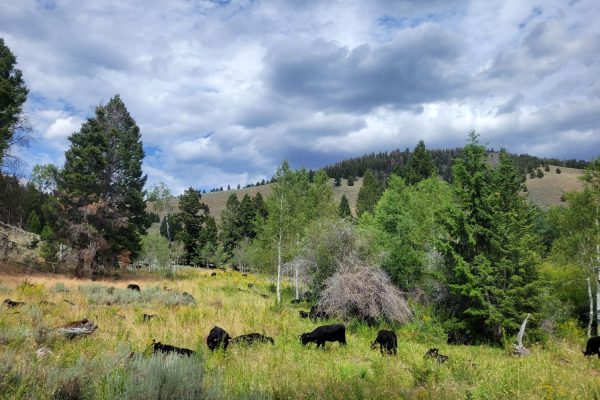Info “bits” about Industrial Beef
This is a hodgepodge collection of information I’ve found in print and on the web. Some of it is from sources that are completely trustworthy, others from sources that might be a bit more suspect. In spite of the latter, however, I find it interesting the variety of criticisms that are leveled at commodity beef.
In no way is this intended as an insult to the many American farmers and ranchers who are trying to produce the best beef possible. Instead, this is an indictment of the “agribusiness industrial system,” a production model that is large in scale and nameless and faceless in nature. Most of these concerns are addressed by a production model of local direct personal relationships between customer and farmer/rancher.
“The smallest number of cattle contributing muscles and/or fat to a single 4-ounce ground beef patty (was) on average, 55 and the greatest number, on average, was 1,082.” (Colorado State University 1998)
Scott Merritt of the Nebraska Corn Growers Association: “We estimate that every pound of beef produced in Nebraska has about seven pounds of corn in it.”
It is estimated that nontherapeutic livestock use accounts for 70 percent of total antimicrobial use in the United States (including human use) (Union of Concerned Scientists 2001).
Without antibiotics, up to 75% of feedlot-finished cattle would have livers unfit for human consumption (Union of Concerned Scientists 2001).
About half the bicarbonate soda produced in the United States—a common home treatment for stomach problems in humans—is fed to cattle to help neutralize the acid in the rumen. Acidosis is a problem only in grain-fed beef. (EAT WILD web site)
“It is “very likely” that hormone residues in North American beef is a factor in the early onset of puberty among girls in recent decades, said Carlos Sonnenschein of the Tufts University School of Medicine at Boston.” (The Canadian Press)
The U.S. imports beef from 26 countries. In 1999 ““ 2000, these countries included Canada, Mexico, Honduras, Nicaragua, Costa Rica, Ecuador, Chile, Brazil, Uruguay, Argentina, United Kingdom, Ireland, Austria, Spain, Italy, Norway, Switzerland, Croatia, United Arab Emirates, Nigeria, Thailand, China, Japan, Australia, New Zealand, and Other Pacific Islands (RCALF position paper, 5 August 2001)
Blakeslee describes how US feed companies, pet food companies, pharmaceutical firms, and nutritional supplement manufacturers have been importing large quantities of possibly contaminated bovine parts and rendered animal protein from Britain. She writes “British export statistics show that 20 tons of ‘meals of meat or offal’ that were ‘unfit for human consumption’ and probably intended for animals were sent to the United States in 1989. And 37 tons were exported to the US in 1997, well after the government banned imports of such risky meat.” (NY Times 1/14/2000)
Up to 50 percent of feedlot cattle being fattened for slaughter during the summer months carried the E. coli O157:H7 bacterium in their intestines. (USDA 2000)
A study on the feasibility of feeding stale chewing gum and its wrappers to cattle found: “Results of both experiments suggest that [gum/packaging material] may be fed to safely replace up to 30% of corn-alfalfa hay diets for growing steers with advantages in improving dry matter intake and digestibility.” (Journal of Animal Science 1999)
Feedlot polio is yet another direct consequence of switching animals from pasture to grain. When the rumen becomes too acidic, an enzyme called “thiaminase” is produced which destroys thiamin or vitamin B-1. The lack of vitamin B-1 starves the brain of energy and creates paralysis. Cattle that are suffering from feedlot polio are referred to as “brainers.” (EAT WILD web site)
Currently using irradiation for meat/poultry: Huisken’s of Minnesota (ground beef, 22 states); Schwan’s home delivery (ground beef); Omaha Steaks; Tyson, IBP (ground beef), Excel (ground beef – the U.S. Dept. of Defense plans to buy irradiated beef from Excel), Emmpak (ground beef), Colorado Boxed Beef (poultry); WW Johnson Meat Company (ground beef for the food service industry); Kenosha Beef International (ground beef; it supplies Burger King, Wendy’s, Taco Bell, Target, A&W Restaurants, Dairy Queen, Hardee’s, and Hot’N Now Hamburgers); Nation’s Pride (chicken to restaurants and food service); Rochester Meat (ground beef products, portion cut steaks and pork, for the foodservice industry). (Organic Consumers)
Some radiolytic products, such as formaldehyde, benzene, formic acid, and quinones are harmful to human health. Benzene, for example, is a known carcinogen. In one experiment, seven times more benzene was found in cooked, irradiated beef than in cooked, non-irradiated beef. Some radiolytic products are completely new chemicals that have not even been identified, let alone tested for toxicity. In addition, irradiation destroys essential vitamins and minerals, including vitamin A, thiamine, B2, B3, B6, B12, folic acid, C, E, and K; amino acid and essential polyunsaturated fatty acid content may also be affected. A 20 to 80 percent loss of any of these is not uncommon. (Nuclear Lunch: The Dangers and Unknowns of Food Irradiation by Susan Meeker-Lowery and Jennifer Ferrara)
The fresh cuts of meat are vacuum-packed in plastic bags, and are allowed to sit at temperatures between 34-38 degrees F for 7 to 28 days. In this hermetically sealed environment the meat ages in its own juices, hence the term “wet-aging.” Since the meat is packed in it’s own juices the enzymes will breakdown the connective tissues and make it more tender. However, because there will be no fluid loss the concentration of flavor that you get from dry aging won’t happen. Nor is there a thick crust to be heavily trimmed as with dry-aged meat, so the meat is considerably cheaper. This helps explain why close to 99 percent of beef—including the meat used at many well-regarded steak houses—is wet-aged. (From “Dry Aged Beef–Try a Little Tenderness” by Sam Gugino.
Since 1981, more than 620,000 productive farms have disappeared, either bought by larger farms or “developed” into ranchettes, subdivisions or strip malls. (Community Alliance with Family Farmers)







Leave a Reply